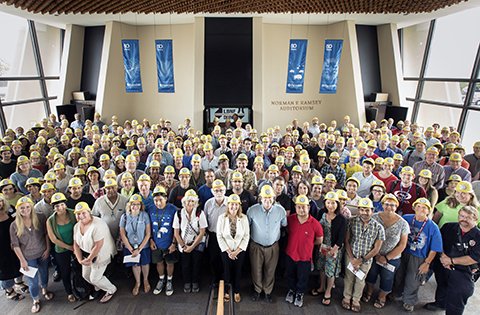University of Minnesota to play key role in planned neutrino experiment

Research provides new insight into the beginnings of the Universe
MINNEAPOLIS / ST. PAUL (07/25/2017) — With the turning of a shovelful of earth a mile underground, a new era in international particle physics research officially has begun. University of Minnesota physicists will play an important role in the project.
The international neutrino research community celebrated a ceremonial groundbreaking at the Sanford Underground Research Facility (SURF) in Lead, S.D. Scientists and political leaders marked the beginning of construction of the Long-Baseline Neutrino Facility (LBNF).
The purpose of LBNF is to provide a new neutrino beam and an underground laboratory to house the Deep Underground Neutrino Experiment (DUNE), which will follow on the path marked by the earlier MINOS and current NOvA Experiments.
Construction of large DUNE prototype detectors is already under way at the European research center CERN, a major partner in the project. Three University of Minnesota Ash River Laboratory staff members, Bill Miller, Curt Leroy and Charles Cadeau, are currently working at CERN in Geneva, Switzerland on a prototype of the eventual DUNE Detector known as ProtoDUNE.
"The University of Minnesota is using its underground physics expertise to play an important role in both ProtoDUNE and eventually DUNE installation," said University of Minnesota Physics Professor Marvin Marshak, a member of the DUNE collaboration.
LBNF will be constructed over the next decade, and will be home to the Deep Underground Neutrino Experiment (DUNE). The U.S. Department of Energy's Fermi National Accelerator Laboratory will send a beam of neutrinos 1,300 kilometers (800 miles) through the earth to a detector that stands nearly four stories tall, built nearly one mile underground and filled with liquid argon. Scientists will study the interactions neutrinos make with argon atoms in a quest to learn more about these elusive yet abundant particles.
DUNE will enable scientists to look for differences in the behavior of neutrinos and their antimatter counterparts, antineutrinos, which could provide essential clues as to why we live in a matter-dominated universe—in other words, why we are all here, instead of our universe having been annihilated just after the Big Bang. DUNE will also watch for neutrinos produced by supernovae, which scientists can use to look for the formation of neutron stars or even black holes.
The large DUNE detectors also will allow scientists to look for the predicted but never observed subatomic phenomenon of proton decay, a process closely tied to the development of a unified theory of energy and matter.
The international Deep Underground Neutrino Experiment (DUNE) was conceived, designed and will be built by a team of 1,000 scientists and engineers from more than 160 institutions in 30 countries.
Neutrinos are the most abundant matter particles in the universe, yet very little is known about their role in the way the universe evolved. DUNE will consist of two particle detectors placed in the world’s most intense neutrino beam. One detector will record particle interactions near the source of the beam, at Fermilab in Batavia, Ill., while the other, filled with 70,000 tons of liquid argon and cooled to -300 degrees Fahrenheit, will take snapshots of interactions deep underground at Sanford Lab in Lead, S.D.
The LBNF will provide the neutrino beam and the infrastructure that will support the DUNE detectors, taking advantage of Fermilab’s powerful particle accelerator complex and Sanford Lab’s deep underground areas. At its peak, LBNF construction is expected to create almost 2,000 jobs in South Dakota and a similar number of jobs in Illinois.
This research is funded by the U.S. Department of Energy Office of Science in conjunction with CERN and international partners from nearly 30 countries.
More information, visit the DUNE website.
